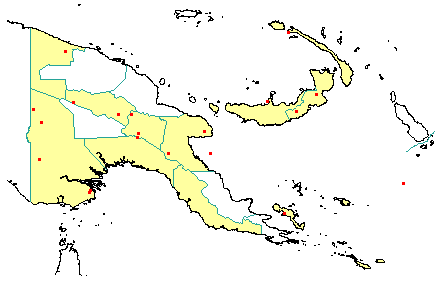
in PNGplants database
PNGTreesKey – Gordonia papuana Kobuski |
Barry Conn (NSW) & Kipiro Damas (LAE).
Guide to trees of Papua New Guinea
Copyright held by the authors, National Herbarium of New South Wales, and Papua New Guinea National Herbarium
Journal of the Arnold Arboretum Vol. 21: 136 (1940)
Other Literature: W.R. Barker, Brunonia 8-14 (1980) Fig. 1.
Family: Theaceae
Dicotyledon
Timber Group: Commercial hardwood
Field Characters: Large canopy tree (up to 36 m high) or Small sub-canopy tree; Bole cylindrical (up to 130 cm diam.); straight (bole up to 27 m long); buttresses buttresses absent or buttresses present (buttresses up to 1 m high); spines spines absent; aerial roots aerial roots absent; stilt roots stilt roots absent; Bark white, black (almost (occasionally), grey, or brown, slightly rough or smooth, finely fissured, sometimes scaly or flaky, or slightly pustular, lenticels elongated vertically; Subrhytidome (under-bark) green, yellow, brown, red, or mottled; less than 25 mm thick; bark blaze consisting of one layer; faintly to non-aromatic; outer blaze yellow, pale brown, white, or pale red, markings absent; inner blaze yellow, pale brown, pale red, or white, markings absent; bark exudate (sap) present, colourless, not readily flowing (spotty), colour not changing on exposure to air, not sticky; terminal buds not enclosed by leaves.
Indumentum: Complex hairs absent; stinging hairs absent; mature twig indumentum (hairs) present when young or absent, hairs sparse to dense (with fine short white hairs).
Leaves: Leaves spaced along branches, spiral (leaves occurring singly at a node and arranged spirally up the branchlet), simple (a leaf composed of a single blade); petiole present, not winged, attached to base of leaf blade, not swollen; leaves broadest at or near middle or rarely broadest above middle or slightly broadest below middle, (3.5-) 7.0-13.0 (-21.0) cm, (1.5-) 2.5-5.0 (-8.5) cm; symmetric, entire, not dissected or lobed, acuminate (short- to long-acuminate), rarely obtuse, or rarely rounded, venation pinnate, secondary veins open, prominent, intramarginal veins absent; leaves lower surface pale green or green (dull (to glossy), upper surface dark green (dull (to glossy), indumentum (hairs) present (sometimes glabrescent at base of lower surface) or absent, indumentum (hairs) sparse; absent; domatia absent; stipules absent.
Flowers: Inflorescence axillary (and extra-axillary), flowers single (strongly and sweetly aromatic), cones absent; flowers bisexual, stalked, flowers with many planes of symmetry, 10.0-23.0 mm long, diameter large (more than10 mm diam.) (20-30 mm diam.); perianth present, with distinct sepals and petals whorls, inner perianth white, rarely pink, or sometimes yellow; 5-7, free; stamens 50-(arranged in 3 whorls)-120, present, at base joined or free of each other, free of the perianth; ovary superior, carpels joined (when more than one), locules (4-) 5; styles free, (4-) 5.
Fruits: Infrutescence single, fruit (15.0-) 20.0-35.0 mm long, 5.0-15.0 mm diam., brown, not spiny (covered with short appressed hairs), non-fleshy, simple (rarely 4-, mostly 5-angled), dehiscent, capsule (mostly separating into 5 valves); seeds 2-(per locule)-3, about 10 mm long (8-10 mm long), winged (with one membranous vertical wing; wing up to 2 times length of seed), narrow (longer than wide), seed 1-10 mm diam. (3-5 mm diam.).
Distribution: West Sepik, Morobe, Western Highlands, Eastern Highlands, Western, Gulf, Central, Papuan Islands, New Britain & New Ireland.
 | Botanical records in PNGplants database |